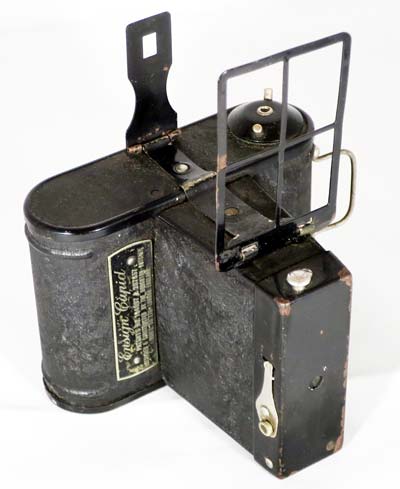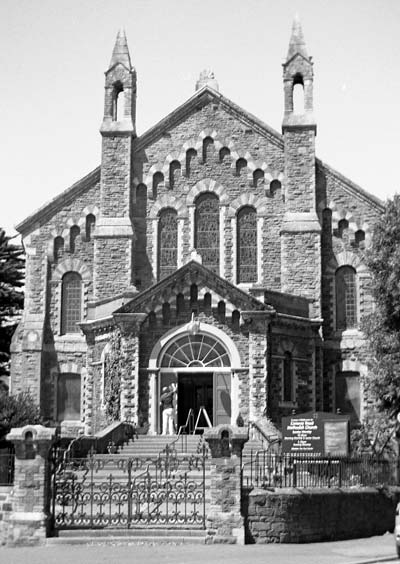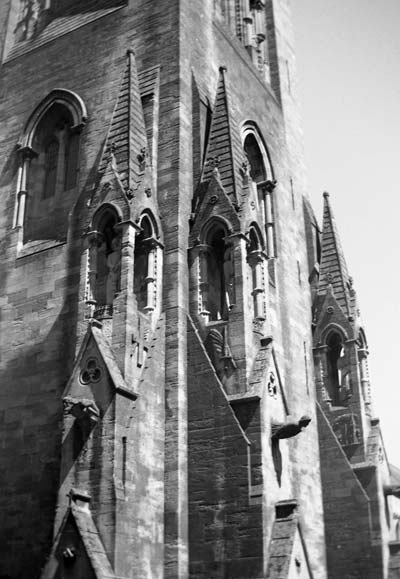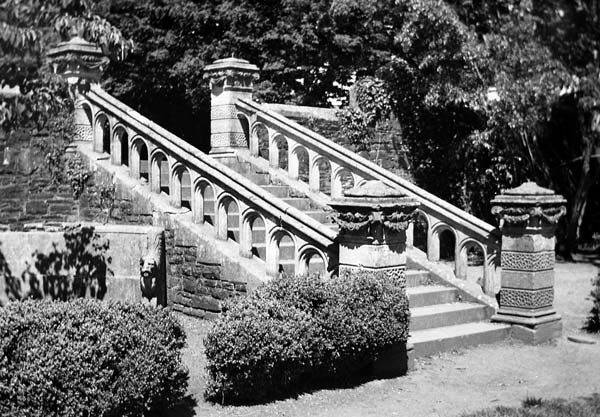Ensign Cupid
Specification

| Manufacturer | : | Houghton-Butcher |
|---|---|---|
| Produced | : | 1922 |
| Classification | : | Medium Format |
| Body Type | : | Solid Body |
| Construction | : | Metal |
| Film Type | : | 120 |
| Film Width | : | 62mm |
| Image Size | : | 2¼ x 1⅜ in |
| No. of Images | : | 16 |
| Lens Type | : | Meniscus |
| Focus Type | : | Fixed |
| Focal Length | : | 70mm |
| Focus Range | : | 10ft to inf. |
| Aperture Type | : | Fixed |
| Aperture | : | f/14 |
| Shutter Type | : | Guillotine |
| Shutter Speeds | : | B,I*(1/30 sec) |
| Size (w x h x d) | : | 100 x 80 x 85 mm |
| Weight | : | 247g |
| * Measured on this camera | ||
Art Deco Credentials
![]()
Limited: Minor and insubstantial
- Produced during the main Art Deco period;
- Quirky Design;
- Crackle black finish;
- Some chrome parts.
Description
The Ensign Cupid is a small sheet-metal bodied camera made by British manufacturer Houghton-Butcher under their Ensign brand. There were three finishes produced, crackle black (common), smooth black (on early models) and dark blue. It has a simple folding frame viewfinder. A brilliant finder accessory was available. It has a quirky T shaped profile.
The camera uses dual red windows to shoot in 2¼" x 1⅜" format. It has two red windows giving sixteen pictures on a roll of 120 film. This was possibly the first camera to use the two window arrangement as it used a design from a British Patent 13246 (W.H. Harvey, 1914) which described using two red windows for doubling the number of exposures on a film roll.
The guillotine shutter is cocked by lifting the button on top of the faceplate and fired with the button below the T/I selector. The shutter speed is about 1/30s and the aperture f/14.
How to Use
This camera takes 120 film which is easily available. To load the film, a catch on the bottom releases the body which slides down for access to the film transport system.
Line up the first number on the roll in the first window 'A' then expose the film. Now move the same number to the second window 'B' and expose the film. Repeat for all 8 numbers on the roll giving 16 exposures. These instructions are shown on the back of the camera. Don't forget to cover the red windows with black tape and only open them when advancing the film in low light conditions. This camera is particularly sensitive to light leaking through the red windows.
As the shutter speed is only 1/30s, it is advisable to use a tripod to get clear shake free images. However, holding it against a wall or other solid object would work as well. For quick snapshots, hold it firmly against your body.
If you don't want to bother with an exposure meter, follow the guide shown. It is based on the 'Sunny 16' rule. Film is so forgiving and will produce acceptable results even when overexposed by 2 or 3 stops or underexposed by 1 stop.
The tables assume that the sun is at least 30 degrees above the horizon - that's 10am - 5pm on a summers day (May - August) in the UK.
Remember that the exposure guide in the manual may not be helpful as it is based on the use of old film with a low ISO value.
Using ISO 100/125 film - shutter speed 1/30s
| Weather Conditions | Shadow Detail | Aperture | Exposure |
|---|---|---|---|
 Sunny SunnySnow/Sand | Dark with sharp edges | f/14 | +3 Stops Overexposed Acceptable |
 Sunny Sunny | Distinct | f/14 | +2 Stops Overexposed Acceptable |
 Slight Overcast Slight Overcast | Soft around edges | f/14 | +1 Stop Overexposed Acceptable |
 Overcast Overcast | Barely visible | f/14 | Good |
 Heavy Overcast Heavy Overcast | None | f/14 | -1 Stop Underexposed Acceptable |
 Open Shade Open Shade/Sunset | None | f/14 | -2 Stops Underexposed Not Acceptable |
Photographs taken with this Camera
Ilford FP4+ film. Developed in D76(1+1)


